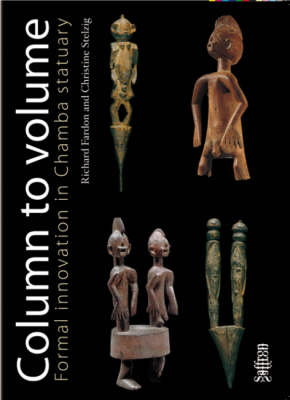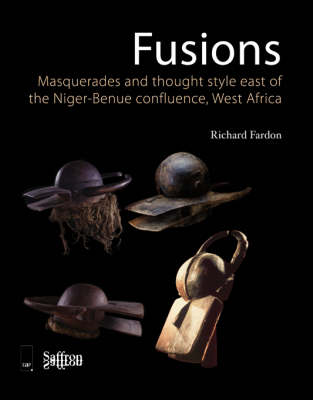Saffron Afriscopes
2 total works
"Column to Volume: Formal Innovation in Chamba Statuary" investigates the appearance on world art markets during the 1970s of statues identified as Chamba from West Africa. Sought after for their artful execution, these statues were stylistically unlike anything previously documented from the region. Are they what the art market claimed? Who made them, when, where and why? To answer these questions, Richard Fardon and Christine Stelzig had to combine the findings of ethnographic research in Cameroon and Nigeria with museum and archival research and the testimonies of art dealers and collectors. Profusely illustrated, "Column to Volume" offers a comprehensive account of an important sculptural tradition in West Africa, as well as fascinating insights into the tribal branding, distribution, and copying, of African art works during the 1970s. Identifying formal innovation in what has been described as 'tribal' tradition, not least by tracing the individual sculptor irresponsible for the most valued Chamba statues, this account by Fardon and Stelzig will transform readers' appreciation of Chamba sculpture.
More than this, their collaboration provides an instructive example of a fresh kind of inter-disciplinary and multi-sited investigation that integrates local context of use, collection histories, art markets and formal artistic appreciation to reflect the local and global context through African artefacts circulated during the 20th century.
More than this, their collaboration provides an instructive example of a fresh kind of inter-disciplinary and multi-sited investigation that integrates local context of use, collection histories, art markets and formal artistic appreciation to reflect the local and global context through African artefacts circulated during the 20th century.
v. 2
Fusions/Masquerades and Thought Style East of the Niger-Benue Confluence, West Africa
by Richard Fardon
Published 9 February 2010
Fusions takes the masks of West Africa's Upper Benue River region out of the museums and private collections, where many accumulated in the twentieth century, and restores their cultural and social contexts. The book argues that Benue masquerades deserve appreciation as the materialized forms taken by the thought styles of their original creators and users. Masquerades are 'theranthropic': they fuse characteristics of animals with those of living and dead human beings to create entities to perform the powers and dangers inherent in people's lives. The subtle variety of the ways that different masquerades, and other performances, achieve this, reveals facets of an understanding of the human condition: of relations between the genders, the living and the dead, animals and people, kings and commoners...By demonstrating the similarities in both their conceptions and uses, Fusions will change the way readers look at, and understand, the masquerades of the entire Benue River.
"Longer blurb: Fusions" takes the masks of West Africa's Upper Benue River region out of the museums and private collections, where many accumulated in the twentieth century, and restores their cultural and social contexts. The book argues that Benue masquerades deserve appreciation as the materialized forms taken by the thought styles of their original creators and users. Masquerades are 'theranthropic': they fuse characteristics of animals with those of living and dead human beings to create entities to perform the powers and dangers inherent in people's lives.The subtle variety of the ways that different masquerades, and other performances, achieve this, reveals facets of an understanding of the human condition: of relations between the genders, the living and the dead, animals and people, kings and commoners, colours, seasons and so forth, shared by the peoples of the Benue.
Part One provides an intensive analysis of Chamba masquerade (of the Cameroon/Nigeria border area), based in fieldwork experience stretching over three decades, as well as accounts both of the history of collection of Chamba masquerades from the earliest colonial times, and of their local formal variation, based on research in museums, private collections and archives. Attention moves westwards in Part Two to an analysis of Mumuye masquerade, and a bold revisionist reading of the many forms of Jukun masks, before surveying the significance of the now-defunct masquerade traditions of the Jos Plateau of Nigeria.Part Three moves eastward from the Chamba to demonstrate that peoples who had no masquerades in the strict sense, nonetheless materialized a similar thought style through their use of actual skulls and animals. By showing the similarities in both their conceptions and uses, "Fusions" will change the way readers look at, and understand, the masquerades of the Benue River region. Profusely illustrated, and with numerous tables and diagrams, the account guides the reader through what is, in art-historical terms, one of the most celebrated of West Africa's style regions.Like its companion volume on statuary (Column to Volume, Afriscopes, 2005), "Fusions" demonstrates the scholarly dividends that come from blending long-term ethnographic familiarity with particular cultures, research in museums and archives, and anthropological comparison based upon a critical rereading of previous writers.
The subject and method of this inter-disciplinary endeavour will interest social anthropologists, art historians and collectors, as well as providing the state-of-the-art account of Upper Benue masquerades.
"Longer blurb: Fusions" takes the masks of West Africa's Upper Benue River region out of the museums and private collections, where many accumulated in the twentieth century, and restores their cultural and social contexts. The book argues that Benue masquerades deserve appreciation as the materialized forms taken by the thought styles of their original creators and users. Masquerades are 'theranthropic': they fuse characteristics of animals with those of living and dead human beings to create entities to perform the powers and dangers inherent in people's lives.The subtle variety of the ways that different masquerades, and other performances, achieve this, reveals facets of an understanding of the human condition: of relations between the genders, the living and the dead, animals and people, kings and commoners, colours, seasons and so forth, shared by the peoples of the Benue.
Part One provides an intensive analysis of Chamba masquerade (of the Cameroon/Nigeria border area), based in fieldwork experience stretching over three decades, as well as accounts both of the history of collection of Chamba masquerades from the earliest colonial times, and of their local formal variation, based on research in museums, private collections and archives. Attention moves westwards in Part Two to an analysis of Mumuye masquerade, and a bold revisionist reading of the many forms of Jukun masks, before surveying the significance of the now-defunct masquerade traditions of the Jos Plateau of Nigeria.Part Three moves eastward from the Chamba to demonstrate that peoples who had no masquerades in the strict sense, nonetheless materialized a similar thought style through their use of actual skulls and animals. By showing the similarities in both their conceptions and uses, "Fusions" will change the way readers look at, and understand, the masquerades of the Benue River region. Profusely illustrated, and with numerous tables and diagrams, the account guides the reader through what is, in art-historical terms, one of the most celebrated of West Africa's style regions.Like its companion volume on statuary (Column to Volume, Afriscopes, 2005), "Fusions" demonstrates the scholarly dividends that come from blending long-term ethnographic familiarity with particular cultures, research in museums and archives, and anthropological comparison based upon a critical rereading of previous writers.
The subject and method of this inter-disciplinary endeavour will interest social anthropologists, art historians and collectors, as well as providing the state-of-the-art account of Upper Benue masquerades.

